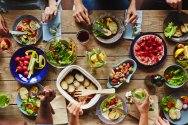
Background
Six dilemmas – part 2: What is the role of the livestock farming sector in the Netherlands?
There are currently 100 million chickens, over 11 million pigs, almost 4 million cows, 850,000 sheep and 480,000 goats in the relatively small Netherlands. This number of livestock can be sustained by the import of animal feed (raw materials) and large volumes of residue streams from the food industry.
This has a significant impact on humans, the climate, the environment and biodiversity. The question is: what do we aim to achieve with our livestock sector, and what scale is needed to achieve said goal? Will we continue to respond to the European and global demand for high-value protein, or will we feed our animals with raw materials unfit for immediate human consumption, such as grass, waste streams and byproducts?
With no further interventions, the global demand for animal proteins is expected to increase in the coming decades, threatening to further increase the pressure on farmland and water to produce feedstock such as soya, maise and grain. The same acreage could also be used to produce human food, thus reducing the impact on the climate, biodiversity and environment. Moreover, the proximity of animals and the density of their populations increase the risk of disease. Still, the livestock sector can play a positive role in maintaining the landscape and nature and, in doing so, contribute to biodiversity and climate adaptation.
The Netherlands may choose to remain a leading exporter of animal proteins. In this case, the large-scale import of raw materials for feed will remain as it is, as will the size of the livestock population and the subsequent production of manure. Far-reaching investments in new technology are required to reduce the impact on the climate and biodiversity. However, the effects thereof are generally less than expected when put into practice, further increasing the costs. Moreover, the risk of animal disease remains considerable in this scenario, as illustrated by the recent outbreaks of avian influenza and blue tongue.
An alternative circular perspective is based on the raw feed materials available within the Netherlands that do not compete with human consumption. This includes grass, residual streams from the food industry, rotation crops and products of which the shelf-life has expired.
The animals’ role will then be to add value to these residue streams by converting them into animal proteins. This system requires fewer animals and less arable land but yields only one-third or one-quarter of our daily protein requirements. Hence, this scenario also calls for a protein transition in which we will consume more plant-based proteins and fewer animal proteins.
There are sub-variants of the above two options, for example, where the Netherlands produces enough food for human consumption while still producing a considerable amount of animal feed as a byproduct through, for example, rotation crops and residue streams from sugar beets, wheat for baking, barley for brewing and potatoes for french fries. On the other hand, plant-based residue streams may also be used as biomaterials in construction or in the chemical industry, reducing their role in circular agriculture.
We feel that the question of what role livestock farming plays in the Netherlands is key. The answer to that question determines the shape and size of the livestock industry. In its current form, the livestock sector’s main challenge lies in its environmental impact, humane animal husbandry and international competition. A circular livestock sector is, by definition, much smaller and less likely to clash with environmental boundaries, but it will also lead to more scarcity of animal products and, thus, to price increases. Therefore, this option also requires a significant change in our consumption pattern.
6 dilemmas
The societal debate on agriculture and nature frequently focuses on slashing the livestock population in half and whether we should aim to achieve the nitrogen targets in 2030 or in 2035. But are there the right questions? A group of Wageningen researchers identified six dilemmas contributing to the Netherlands’ future course of agriculture and nature.
In the series “6 Dilemmas”, each of the dilemmas is discussed in more detail.


